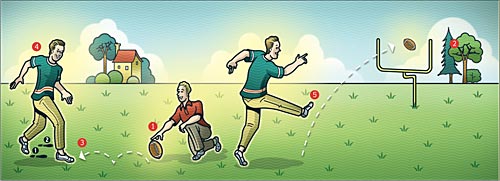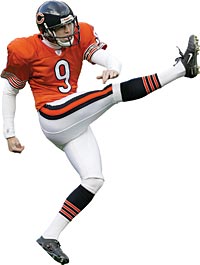Physicists can explain the mechanics of kicking a field goal-measuring stuff like angular velocity, linear momentum, rotational kinetic energy, and leg mass in a complicated equation. But back on the field, Bears kicker Robbie Gould has a simpler explanation: "It's really just a lot of practice—kick a lot of kicks," he says.
|
|
Step one: Pick a spot to place the ball-preferably a dry, flat area of the field that hasn't been chewed up.
Step two: Find your reference point behind the goalpost. This is where you aim the ball, typically the center of the uprights.
Step three: Take two steps backward, then two steps to the left, and eye your target one last time. Tell the holder that you're ready for the set call.
Step four: Start your approach once the holder lifts his fingers off the ground. Gould prefers the ball placed straight up but tilted slightly. Plant one foot about 12 inches away from the ball and swing the other foot forward.
Step five: Make contact. Gould kicks with the instep of his foot, "soccer style," not with the tips of his toes. For maximum distance, make contact around the center of the ball or a tad below the center.
|
|
Great moments in Bears field goal history: + Bob Thomas, now a justice on the Illinois Supreme Court, shares the team record for the longest field goal. He nailed a 55-yarder against the L.A. Rams in 1975. Super-kicker Kevin Butler twice made 55-yard field goals in the 1993 season. + Robbie Gould ranks as the most accurate kicker in team history among kickers with at least 25 attempts. + In 1944, the Bears took first place in the NFL in fewest field goal attempts. Total tries: zero. |
You Should Know
The official NFL Wilson football weighs 0.91 pounds.
A football's launch speed is 74 miles per hour for a typical punt, 93 miles per hour for a kickoff, and somewhere in between for a field goal.
The average force of the kicker's foot during a kick is about 450 pounds, causing the ball's shape to deform. At the point of first contact, the force can reach as much as a ton.
The foot is in contact with the ball for roughly .008 second.
Footballs don't have "sweet spots." Kickers who speak of sweet spots are probably referring to the middle of the football, where they typically aim.
Source: The Physics of Football, Timothy Gay
illustration: Peter And Maria Hoey; photograph: Jonathan Daniel/Getty Images




